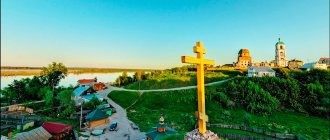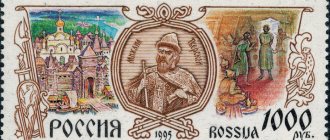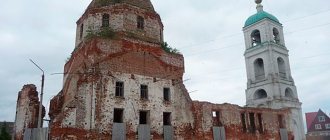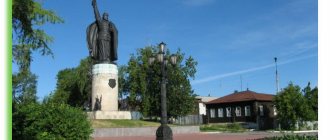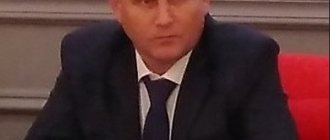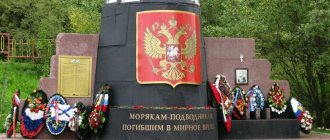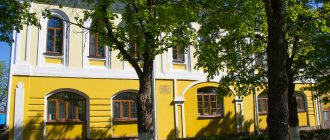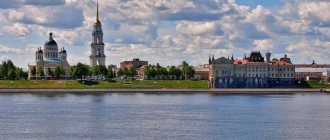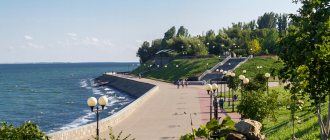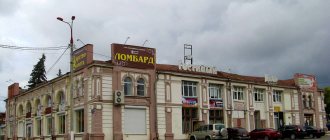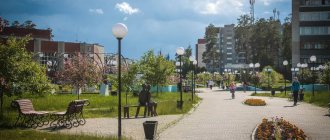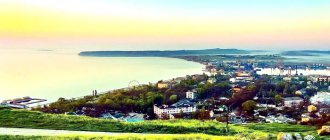The city of Murom is an open-air monument, founded in 862.
The museums in Murom are very interesting; the attractions have a long history. You can easily watch them in one day.
The best sights of Murom: the monument to Ilya Muromets in Murom, the armored train "Ilya Muromets", the sculpture "Murovsky Kalach", "Epic Stone", the Muromsky Bridge, the Holy Trinity Convent, the Transfiguration Monastery and the Annunciation Monastery.
The film “The Man from the Boulevard des Capucines”, released in 1987, was filmed in Murom, very popular in Soviet times.
A few facts about Murom
- Murom is located on the border with the Nizhny Novgorod region.
- It was first mentioned in the Tale of Bygone Years in 862 , this year is considered the date of its creation.
- The first Murom prince Gleb Vladimirovich from the Rurik family (reigned 1013 - 1015) is known for the fact that, together with his brother Prince Boris, he was killed by his brother Prince Svyatopolk the Accursed, for which he was canonized. Gleb and Boris are considered the first saints in Rus'.
- In 1097, Prince Yaroslav Svyatoslavovich (Constantine) put an end to paganism in the city by baptizing the population. Moreover, the renunciation of the new faith was not voluntary: the prince’s son was killed by disgruntled townspeople. The reign of Yaroslav is associated with economic prosperity and internecine wars.
- For the next century, the throne was divided between the sons of Yaroslav: Yuri, Svyatoslav and Rostislav. In the 13th century, Murom was subjected to a devastating raid by the Tatar-Mongols, and in 1293 it became the victim of a large-scale fire.
- Only in 1351 did a white streak begin in the history of the city after the annexation of Murom by Vasily I to the Moscow lands.
- At the beginning of the 16th century, the city was overtaken by an epidemic that wiped out almost the entire population.
- Murom survived both the Time of Troubles and the fires of the late 18th and early 19th centuries. At the same time, the city has always remained an important trade and craft center of Rus' due to its advantageous geographical position: leather craftsmen, gunsmiths, tailors, carpenters, jewelers, and bakers were famous far beyond its borders.
- Now the population of Murom is 109 thousand people, it is the third city in the Vladimir region in terms of population.
- The distance to the city of Gorokhovets is 97 km, Gus-Khrustalny is 110 km, to the regional center of Vladimir is 130 km, to Suzdal is 170 km.
Monuments and parks in Murom
Panorama of Murom is an attraction in its own right. Historical monuments of Murom are found here in large numbers. Murom is part of the Golden Ring of Russia, which is famous for such cities.
Monument to Ilya Muromets in Murom
The height of the Monument to Ilya Muromets is 21 meters. Ilya Muromets looks at the Oka, which in ancient times was the border of the State. The warrior is dressed in a helmet and monastic robe. This hero really existed. Oddly enough, many people became aware of this after the construction of the monument.
Address: st. Oksky Congress, 11, Murom, Vladimir region, 602267
Monument to Ilya Murovets
Armored train "Ilya Muromets"
In the park of the 50th anniversary of Soviet power you can see a replica of the steam locomotive of the armored train “Ilya Muromets”, which actually reached Germany from 1942 to 1945, destroying a huge amount of enemy equipment and enemy soldiers and officers. At the same time, the Ilya Muromets itself was never seriously damaged.
Address: Park named after the 50th anniversary of Soviet power.
Armored train "Ilya Murovets"
Epic stone
The epic stone is a monument located at the entrance to the city border on the side where the highway leads from Vladimir. It was installed in the 60s of the 20th century by the architect Bespalov; it is the stone face of the legendary hero. The inscription on the monument says that in 862 the first settlers settled in the place of Murom, as stated in the Tale of Bygone Years.
Address: Vladimirskoe highway, Murom, Vladimir region, 602266.
Monument to Peter and Fevronia
The first monument to Saints Peter and Fevronia was built by Vladimir Surovtsev at his own expense. As the legend says, Prince Peter married the commoner Fevronia, who cured him of leprosy; in his old age they lived in different monasteries, for which they had to separate, but they died at the same time, literally in the same hour.
Water tower
Until the mid-19th century, residents of Murom took water from the river every day. In the 1860s, a tower was built to help water enter the pump. For a long time it was the tallest, so it was also used as a fire tower.
Address: Sovetskaya st., 15, 602267.
Sculpture "Murovsky Kalach"
The monument to Murom Kalach is located not far from the market. This type of baking was born here. The height of the sculpture is about two meters, and it weighs about 100 kg.
Address: st. Lenina, 22, 602267.
Muromsky Bridge
The cable-stayed bridge across the Oka River connects the Vladimir and Nizhny Novgorod regions. Until 2006, there was a pontoon bridge that could only be crossed in the summer. at other times, the only way to cross the river was by ferry. The Murom Bridge is one of the most large-scale projects of the 21st century.
Address: P72, Nizhny Novgorod region, 602209.
Muromsky Bridge
Monument to Zvorykin
Vladimir Zworykin is known as the father of modern television, as well as the man who made many other inventions. A monument to him was erected near his house in Murom in 2013. He is depicted as a young man - a student at the St. Petersburg Technical Institute. The author of the work is Pavel Shchelov.
Address of the monument: Pervomaiskaya street, 4.
Square named after the 1100th anniversary of Murom
The main square of Murom dates back to the 16th century. It changed names until it was renamed in 1962 in honor of the 1100th anniversary of Murom. On different sides there are shopping arcades and a market. On the site of the monument to Lenin there used to be a wooden temple.
Victory Square in Murom
Muromskaya Pobedy Square is located between Sovetskaya Street and Lev Tolstoy Street. In the center of the square there is a memorial dedicated to the Great Victory.
Address: Lev Tolstoy street, 21.
Shopping arcades in Murom
In the 17th-18th centuries, an important place on Murom Square was given to various shops. In the mid-19th century, the wooden structures were demolished and stone shopping malls were built in their place. Now only a few buildings remain. They are also intended for trading.
Address: pl. 1100th anniversary of Murom, Murom, Vladimir region, Russia, 602267.
Oksky, park of culture and recreation
Once upon a time there was a pagan sanctuary on the site of Oka Park. Then the Kremlin made of wood stood here. The fortifications were dismantled in the 18th century. The initiator of the creation of Oka Park in the center of Murom was Prince Trubetskoy in the second half of the 19th century. Now this place is very popular among walkers.
Address: Pervomaiskaya st., 1, Murom, Vladimir region, 602267.
Square and bust of A.V. Ermakov
Ermakov Square was opened in the fall of 2012. This space is designed for walking. A monument to Alexey Ermakov is located here. This city mayor from 1862 to 1869 did a lot of good for the city.
Address: st. Lenina, 22, Murom, Vladimir region, 60226.
Karatygin's house
The ruins on Timiryazev Street in Murom were once a solid building, namely Karatygin’s house. It was built in 1837 by the merchant Shvedov. When he died, Karatygin bought the house. Part of it was rented out. Then the Council of Workers' and Soldiers' Deputies was located there. Later the house fell into disrepair. So far no one is talking about its restoration.
Address: st. Timiryazeva, 3, Murom, Vladimir region, 602267.
S. Karacharovo
The ancient village of Karacharovo, part of Murom since 1960, is considered the birthplace of Ilya Muromets. But this has not been officially proven. However, residents have no doubt about it. House No. 279 on Priokskaya Street is considered to be the place where he lived.
Monument to Ilya Muromets
Address: Oksky Congress, 9
The monument to Ilya Muromets was erected in the hero’s homeland - in the city of Murom, on the high bank of the Oka River in 1999. The sculptor is Vyacheslav Klykov (1939-2006), the author of many famous monuments, including Marshal Zhukov on Manezhnaya Square in Moscow.
The bronze epic hero is presented as both a warrior and a monk. He stands holding a sword in a high hand, with his left hand he presses an Orthodox cross to his chest. Under the warrior's armor is a monastic robe. The monument to Ilya Muromets has become a symbol of the city; next to it there is an observation deck on the Oka River.
Sights of Murom on the map
How to get there
Murom is a destination for many tourists. From Moscow you have to travel 313 km by car. By bus, a 7.5-hour journey costs from 776 rubles. By train the journey is 4-4.5 hours, tickets cost from 500 rubles. There is no airport in Murom. It will take an hour to fly from Moscow to Nizhny Novgorod by plane, tickets cost from 6,300 rubles in both directions, from St. Petersburg - 1 hour 40 minutes, you will have to pay 7,000 rubles for tickets. You can get from the airport by Uber taxi for 3,200 rubles in 2 hours and 20 minutes.
The most convenient way to get to Murom is by train. Time from 4 hours, from 1200 rubles.
Public transport and taxis
Murom is a small town, so it’s better to walk here. But you can also travel by public transport, which goes to all the attractions; the fare is 22 rubles; you can take a taxi for 100-300 rubles. around town. The transport sector is well developed, buses and minibuses run everywhere. The sphere of private transportation is also very well established.
10 Interesting facts about Murom
- Murom is approximately three centuries older than Moscow.
- According to one theory, Murom received its name thanks to the Finno-Ugric tribe Murom, who once lived here.
- During the reign of Ivan the Terrible, this was a gathering place for troops going to conquer the Kazan Khanate.
- Murom rolls were initially made using a new technology for that time, which did not require any special devices.
- Once upon a time, the Murom-Ryazan land was one single principality.
- The wooden Murom Kremlin stood for almost two hundred years, when Kazan was conquered, its significance was lost, and Catherine II ordered it to be dismantled.
- Murom was once part of the Vladimir and Moscow provinces.
- Murom is the birthplace of Vladimir Kozmich Zvorykin, the creator of television.
- There are many bodies of water in the vicinity, named by toponyms.
- There is a monument to Ilya Muromets, who was actually a warrior monk.
In Murom you can get a lot of impressions and take great pictures. You can see the sights in one day. The city is small, but it contains a lot of good things. The Vladimir region is of great value for the whole of Russia. There are many historical monuments here that you want to visit again and again.
Annunciation Monastery
Address: Krasnoarmeyskaya st., 1.
Erected in the 16th century by decree of Ivan the Terrible in honor of the capture of Kazan on the site of a wooden church of the 12th century, the Annunciation Monastery houses the relics of the blessed Prince Constantine (Yaroslav) and his sons Fyodor and Mikhail - fighters for the Orthodox faith, as well as the Venerable Elijah of Muromets.
In addition to the monastery, the Annunciation Cathedral with icons from the 16th century has been preserved. The remaining buildings are buildings reconstructed after the Polish intervention. Services in the monastery did not stop even during the period of Soviet power, and the monastery was officially opened in 1991.
Temples and monasteries
Murom land is illuminated by numerous religious buildings, which are replete with city guidebooks. Among the monasteries and temples we can highlight:
Holy Cross
Holy Cross women's monastic monastery is an Orthodox shrine and architectural monument. The first description of this building dates back to the 13th century. According to the ancient story, in this temple Prince Davyd Yuryevich found the “Agrikov Sword”. There is also an assumption that in the same place Princess Euphrosyne took a monastic vow. The religious building has not been preserved in its original form. At the beginning of the 20th century it was blown up, but in 2009 a new building was erected on the site of the ruins and a convent was opened.
Voskresensky
There are attractions in Murom, photos with descriptions of which attract with their colorfulness. The Resurrection Monastery is associated with the legend of Peter and Fevronia. According to it, the prince and his wife lived in the place where the monastery stands. They illuminated this land with their presence, and at the beginning of the 17th century the first temple appeared on it. Near the monastery there is the holy spring of Peter and Fevronia, to which hundreds of people come all year round.
Blagoveshchensky
The Annunciation Monastery was erected on the site of a wooden church, built on the initiative of Prince Yaroslav Svyatoslavovich. The men's monastery was created in the mid-16th century by decree of Ivan the Terrible. Until 1923, the ashes of Prince Constantine and his two sons rested within the walls of the shrine. Then they were opened and transported to the museum. The main temple of the complex is Blagoveshchensky. Its external decoration is an example of Russian patterning of past centuries.
Holy Trinity
The Holy Trinity Shrine was created at the end of the 17th century on the initiative of the local merchant Tsvetnov. It was built on land where Christian churches were located in ancient times. Initially, a cathedral was erected from stone, and later a convent appeared with it. The monastery contains the relics of the family’s patrons - Peter and Fevronia.
Spaso-Preobrazhensky
On the map of the city, to the left of the Oka, the Spaso-Preobrazhensky monastic shelter is indicated. This is the oldest monastery of monks, which arose during the 10th-11th centuries. The monastery is mentioned in the Tale of Bygone Years. There is an opinion that this is the first shelter of monks to appear in Rus'. The complex includes five architectural objects that have been awarded the title of historical monuments of federal significance.
Nikolo-Naberezhny
Nikolo-Embankment Church flaunts on a hill near the river. Under the mountain on which it is located, the Nikolsky spring flows. According to legend, the appearance of St. Nicholas the Wonderworker occurred several times near the holy spring. The “Life-Giving Spring” chapel was built nearby in honor of the icon of the Mother of God. The first evidence of the church dates back to the 15th century. The stone walls were erected in 1714. The main value of the temple is the ashes of Juliania Lazarevskaya.
Kosmodemyansky
Kosmodemyansky parish is one of the oldest architectural monuments. The construction dates back to the 16th century. According to legend, the church was created on the spot where Ivan the Terrible rested in a tent during his campaign against the Tatars. The building has not been preserved in its original form, since its high tent collapsed in the 19th century. Restoration work is currently underway, but the height of the tent will no longer be the same. The architects came to the conclusion that the old walls of the temple would not be able to withstand the previous height.
Guria, Samona and Aviva
Many of Murom's attractions have a special history of creation. And the church of Guria, Samon and Aviv is also one of them. The temple was built with the investment of the tradesman Sintsov. When there was a plague epidemic in the city, the merchant promised that if his family survived, he would build a church. And he kept his promise. In the photo and in reality the shrine looks modest. The building is single-domed with a golden dome. There is an ancient cemetery around it. The temple attracts tourists with a unique icon with particles of the relics of Ilya of Muromets.
Holy Trinity Monastery
Address: Krestyanina Square, 3A.
Holy Trinity Convent, built in the 17th century at the expense of the merchant T.B. Tsvetnova, is a famous place of pilgrimage because of the relics of Saints Peter and Fevronia stored there.
According to legend, the young people fell in love with each other and dedicated their lives to God, bequeathing to bury them together. However, after death (on the same day and hour), the bodies of the lovers were buried in different coffins according to the tradition of monasticism. But a miracle happened: the next morning the coffins were empty, and Peter and Fevronia rested in a common coffin prepared in advance for them.
Now the relics of the saints are kept in the Trinity Cathedral - one of the three operating buildings of the complex (along with the Kazan Gate Church with a bell tower), and the territory of the monastery is decorated with a monument in honor of the patron saints of marriage. Here is also the wooden church of St. Sergius of Radonezh of the 18th century, moved from the village of Krasnoe.
Epic stone
"Epic Stone" at the entrance to Murom
At the entrance to the ancient city of Murom from the north, from the side of Vladimir, there is a sculpture carved from stone of Ilya Muromets. Here they honor the memory of the epic hero, who, according to folk legends, was born in the village of Karacharovo, near Murom. The image of the hero became, as it were, an emblem, a coat of arms of the city. From the point of view of historical significance, the epic stone is the main attraction of the city. An inscription from the chronicle “In the summer of 6370 (862)… was carved into the stone. And pine trees grow next to the stone, and everyone certainly remembers the famous folk song “There were three pine trees on the Murom path...”. 1967 Artist S.A. Nikolaev, architect N.A. Bespalov. “The Epic Stone of Ilya Muromets” is located at the entrance to the city of Murom from the direction of Vladimir.
Zworykin House
Zvorykin House
The Zvorykin House (located on Pervomaiskaya Street, 4) is the main building of the Murom Historical and Art Museum.
The three-story mansion with a mezzanine from the 19th century is one of the largest and most beautiful houses in the city. A world-famous scientist, “the father of television,” Vladimir Kozmich Zvorykin (1889-1982) was born and spent his youth here. There is a memorial plaque installed in the Zvorykin mansion in Murom, and a monument is located in front of his home. For a long time, the Zvorykins’ house housed exhibitions on the history and culture of Murom.
Monument to V.K. Zvorykin in Murom
Monument to V.K. Zvorykin in Murom was installed on July 31, 2013. The monument was installed near the walls of the house of the outstanding Murom inventor of television on Pervomaiskaya Street, 4 (building of the Murom Museum). It was here that Vladimir Zvorykin spent his youth, and this is where his complex, eventful and great destiny began. Friend and biographer V.K. Zworykin Frederick OLESSI said this about Zworykin: - Without a doubt, Vladimir Zworykin is one of the greatest people who have ever walked this planet. And we are absolutely right in honoring his memory here, in the country where he was born, because despite the fact that as a scientist he belongs to the world, he will always remain an example of a unique Russian soul.
A kind of “illustration” of one of his deeds in Murom lies in the courtyard of the Zvorykins’ house. This is a giant oak stump, with a sign next to it: “According to legend, Ilya Muromets uprooted such oak trees, threw them into the Oka and changed the course of the river. This oak tree fell into the Oka River in the 16th century at the age of 300 years. In 2002, the oak was raised by Murom river workers from the bottom of the Oka River on the Spassky rift, 197 kilometers from the mouth. The stump has a diameter of 1.5 meters, a girth of about 4.6 meters, and was cut from a whole tree raised from the bottom of the river. See Historical and Art Museum of Murom.
Monument to Lakin M.I.
Monument to Lakin M.I. Lakin Mikhail Ignatievich was born on November 5 (17), 1876 in the village of Saksino, Murom district (Vladimir province) - Russian social democrat, one of the participants in the workers' strike in Ivanovo-Voznesensk in 1905. Opening of the monument to M.I. Lakin in Murom took place in 1967. The opening was attended by relatives of the Murom revolutionary. In memory of the Murom revolutionary, streets were named and memorials were erected in other cities. In 1922, the Undol textile factory of the Bazhanovs and the village at the factory, which in 1969 was transformed into the city of Lakinsk, were named after Mikhail Ignatievich Lakin. A street and passage in Vladimir, a street in Ivanovo, a street and exit in Murom, streets in Sobinka and Kokhma were also named in memory of the revolutionary. In the village of Undol, which became part of Lakinsk, on a street also named after Lakin, a memorial stone was erected at the site of his death. A monument was erected in the park opposite the Lakinskaya Manufactory spinning and weaving factory. There is a memorial plaque on one of the houses on Lakina Street in Ivanovo. In 1985, in connection with the 80th anniversary of the strike in Ivanovo-Voznesensk, a bronze bust of Lakin was installed at the Krasnaya Talka memorial complex. Memorial complex in memory of the Murom residents - participants in the liquidation of the consequences of the accident at the Chernobyl nuclear power plant. st. Moscow.
“In memory of the courage of the residents of Murom and the region shown during the liquidation of the consequences of the disaster at the Chernobyl nuclear power plant and other nuclear facilities.”
Memorial cross
“The cross was installed in memory of Archpriest Gavriil Vasilyevich Yastrebov. He served as a priest in this Church of the Ascension of the Lord for 47 years. He rested in Bose in 1897 on February 14 (old time). He was buried near the altar of the church.
See Church of the Ascension.
Monument "Mourning Angel"
Monument “Mourning Angel”
The figure of an angel was carved from armor plate on the “Muromteplovoz”.
The pedestal was made of granite, specially delivered from Karelia. The inscription was engraved on it: “Hot spots and a shot in the night... And in the heart, like a bell, memory knocks.” “The Mourning Angel” became, in a way, the repentance of the Murom residents to their fellow countrymen who went through the terrible roads of wars in Afghanistan, Chechnya, Tajikistan, Abkhazia, Transnistria, as well as those who died in “hot spots”. The monument is located in the park on the street. Moscow, near the Murom Orthodox gymnasium of St. Elijah Muromets. Monument “Union of Love - Wise Marriage”
Address: st. Lenina, 55a, at the entrance to the Murom registry office. The official name of the monument is “Union of Love - Wise Marriage.” Sculptor Nikolai Shcherbakov. Saints Peter and Fevronia are depicted as two kneeling figures, tenderly stretching out their hands to each other. The sculpture is secular, quite modernist, so they did not install it near monasteries. Opening date: July 8, 2008 (memory day of Peter and Fevronia of Murom). In 2008, when the day of remembrance of the holy noble princes Peter and Fevronia of Murom - July 8 - was officially declared a holiday, the Day of Family, Love and Fidelity, a campaign began in Russian cities to install monuments to Peter and Fevronia. And, logically, the first two monuments in Russia appeared in Murom.
Bas-relief of Peter and Fevronia
Bas-relief of Peter and Fevronia
The bas-relief of Peter and Fevronia was installed at the western monastery wall of the Transfiguration Monastery in Murom and was installed on July 8, 2008. See Peter and Fevronia.
Labor Square
Moskovskaya Street ended where the roofing felt factory is now. Behind the stone bridge over the Muromka River, which was encased in reinforced concrete armor back in the sixties of our century, the Moscow outpost began. However, for a long time this place was not called anything, and when a house with a Sporting Goods store was built in the sixties, it was assigned to Moskovskaya Street. At the former Moscow outpost, Labor Square was formed and got its name in the 60s. The first to appear was a nine-story building for workers at a roofing felt factory; a year later, two more of the same type with a large store below stood nearby. A park was laid out along the entire length from Moskovskaya Street to the railway line, and a monument to Labor was erected in the center. A seven-story hotel was built on the northwestern side of the square. On the opposite edge there is a bus station. From here, buses depart daily to Moscow, Nizhny Novgorod, Ivanovo, Vladimir, Gorokhovets, Vyazniki, Melenki and almost all settlements of the Murom region. The lines are served by a passenger motor transport company. The history of this company's staff goes back only 30 years. Even after the end of World War II, there were only two or three buses running around the city. They carry more than 29 million passengers per year.
Monument to Labor.
Obelisk in memory of the revolutionary events in Murom in 1905. 1965 Installed near the Buchikha ravine.
Revolution square
Monument-obelisk to participants in the revolutionary events of 1905
An obelisk monument dedicated to the participants in the revolutionary events of 1905 was installed on the square on Pervomaiskaya Street. The exact date of installation is unknown; most likely, the obelisk dates back to the 1920-1930s. The words are engraved on the plaque: “Obelisk in memory of the first proletarian revolution of 1905. In defense of the rights and freedoms of the workers of Murom.” Address: Murom, crossroads st. Pervomayskaya and st. Vorovsky. See The Emergence of the Murom Party Organization.
1965
Kazanka (district of Murom)
Certain parts of the city have unofficial folk names. On the territory adjacent to the Moscow-Kazan railway line, there is one of the oldest districts of the city, called Kazanka. With the construction of the Moscow-Kazan Railway, which took place three kilometers from the city, civil buildings began to appear here, and railway workers and their families began to settle. With the opening of railway workshops in 1916, this process accelerated. Several streets of standard houses appeared, built by the entrepreneur for workers and management. Later, already during the years of Soviet power, the development of workshops, which in 1926 turned into the Dzerzhinsky steam locomotive repair plant, and the opening of a switch plant led to an increase in housing and cultural construction. Steam locomotive repair workers opened a large workers' club, railway workers created a stadium, expanded the hospital and clinic. However, as before, between the station, the factory and the village that arose around them on the one hand, and the city on the other, there remained a huge three-kilometer wasteland - a city pasture for livestock. Probably because the village grew up near the railway line, the Murom residents began to call it Kazanka among themselves. On Kazanka means far from the city. Before the war, the streets that began at the Kazan Railway station almost reached the station of the railway line to Kovrov. But only in the post-war period did large housing construction begin, merging Kazanka with the city. The construction of Shcherbakova Street has essentially been completed. Along the eastern side of the plant named after. Dzerzhinsky in the 60s. Zheleznodorozhnaya Street grew, later renamed Filatov Street, in honor of the Hero of the Soviet Union, former chief designer] Vyacheslav Ivanovich Filatov[/anchor]. Filatova Street starts at the station and, reaching the northern part of the plant named after. Dzerzhinsky, breaks off. Just a quarter of a century ago there were only two or three wooden houses on it. In the year of the fiftieth anniversary of Soviet power, diesel locomotive builders reconstructed the square between the factory gates and the street, and moved here the monument to F.E. from the internal territory of the enterprise. Dzerzhinsky.
Monument to Dzerzhinsky
Opposite there were residential buildings, dormitories, music school No. 1, a road department building, and shops. Nowadays, Kazanka has turned into a large industrial and residential area of the city. During the years of Soviet power, railway divisions developed, new industrial enterprises appeared: factories for reinforced concrete products, brick factories, reinforced concrete structures, bakery products, and a cold storage plant. Source: Pudkov D.P. P88 Murom: Historical-Econ. Feature article. – 2nd ed., rev. And additional – Yaroslavl: Verkh.-Volzh. Book Publishing house, 1987-176 p.
Station Square named after. N.F. Gastello
Monument “In honor of the immortal feat of Captain N.F. Gastello"
Bust of N.F.
Gastello See Muromsky railway station.
Park named after N.F. Gastello
Stele “Wing” In connection with the 40th anniversary of the feat of N.F. Gastello in 1981, the “Wing” Stele was erected in the park in honor of his name. The monument to the first Murom Hero of the Soviet Union, pilot Nikolai Frantsevich Gastello, juts high into the sky. The inclined stele mounted on the slab depicts the pilot's plane in the rapid movement of the last decisive impulse. The winged car, as conceived by the authors, appears completely embedded in the ground. And the wing of an airplane with a golden star rises heroically above the ground. See Park named after N.F. Gastello
To victims of political repression
“Our grief is immeasurable for the torment of your innocents.
May the bitter memory of descendants save us from the return of the terrible past.” Memorial complex in memory of victims of political repression.
1996 Architect V. Shepeta. st. Lenin, square opposite school No. 3. See Victims of political repression of the Murom region and the city of Murom Voznesensky square
In 1788, Empress Catherine II approved a new urban development plan for Murom, which is why the historically established radial-ring scheme of the city did not receive further development. The new project introduced a rectangular grid of streets with many small standard blocks. The compositional center of this plan was Voznesenskaya Square at the intersection of Moskovskaya and st. L. Tolstoy. In 2015, a new city square with a park was opened. It appeared near the Ascension Cathedral (the Cathedral of the Ascension of the Lord is located at the intersection of modern Moskovskaya and Leo Tolstoy streets), receiving the name in honor of this temple. The Church of the Ascension of the Lord, built in 1729, is a special place for Murom residents. Located in the heart of Murom, this temple is considered one of the most beautiful in the region. The fountain has now become a decoration of Voznesenskaya Square.
Fountain on Voznesenskaya Square
Fountain in Voznesensky Square
Ascension Cathedral
Belyakov Square
In the area of the square there previously stood the Nikolo-Mozhaisk (Kazan) Church.
Monument to twice Hero of Socialist Labor, aircraft designer R. A. Belyakov. 1984 Sculptor V. Fetisov, architect J. Arndt. st. Pervomayskaya - Komsomolskaya.
Rostislav Apollosovich Belyakov - Soviet and Russian aircraft designer, general designer of the Design Bureau named after A.I. Mikoyan. Rostislav Apollosovich was born and spent his childhood in Murom, on Gubkin Street. Graduated from the Moscow Aviation Institute named after. Sergo Ordzhonikidze became a design engineer. R.A. Belyakov developed 250 projects of military aviation equipment, under his leadership a whole family of light front-line fighters was born and grew, training and so-called MFIs were created - fifth-generation multifunctional front-line fighters. R.A. Belyakov - Twice Hero of Socialist Labor, laureate of the Lenin, Stalin 1st degree and State Prizes, honorary president of the Russian Academy of Aviation and Aeronautics, honorary member of the Royal Society of Aeronautics (Great Britain), honorary professor of the Moscow Aviation Institute and Peking University. On February 23, 2000, Russian President Vladimir Putin presented academician Rostislav Belyakov in the Kremlin with the Order of Merit to the Fatherland for services of the second degree.
Monument to Krasnukhin Alexander Mikhailovich
Monument to Alexander Mikhailovich Krasnukhin (1908-1982) The monument was erected in 1983. Sculptor I.V. Beschastnov Architect V.N. Fitkovsky
Trinity Square
Trinity Square is located behind the Holy Trinity Monastery, in front of the Annunciation Monastery. Previously it was called Horse Square, after the place where horses were traded. With the appearance of the monument to Peter and Fevronius, the square radically changed its appearance.
Monument to Peter and Fevronia
Monument to Peter and Fevronia
The opening of the monument to Peter and Fevronia took place on July 7, 2012 on Peasant Square, between the Holy Trinity Convent and the Annunciation Monastery. In ancient times, the Prince’s Court was located on the “Monastery Glade,” so the installation of the monument resembles the symbolic return of the holy princes to the place of their life. The two-meter bronze sculptural composition is installed on a granite pedestal of the same height. The author of the monument is People's Artist of Russia Vladimir Surovtsev. It was created at the expense of the sculptor himself. Opening of the monument to Vladimir Lenin in the city of Murom on the square near the walls of the Trinity Monastery. November 7, 1927
“Forgotten monument. In 1925, in response to the call of party and Soviet organizations to build a monument to V.I. The proletarians of Murom warmly responded to Levin. We collected about two thousand rubles, placed an order in Leningrad, and the monument was soon sent. Meanwhile, it was a rainy and frosty autumn. Murom residents, continuing the work they had begun, despite the frosts, laid the foundation in order to inaugurate the monument by May 1, 1926. 1926 has passed... New people, new views, and as a result, conclusions - the foundation was laid incorrectly and it needs to be redone. This is the second year that a project for this foundation has been drawn up, and the monument itself still lies in boxes and matting in the City Council barn” (“Call,” August 24, 1927).
Peasant Square in Murom with a view of the Trinity Convent. 1956
Ensemble of the Trinity Monastery in Murom. 1960s.
Funeral wreaths at the foot of the monument to Joseph Stalin in Murom. 1953
Square of victory
In every city, town and village there is a square of people's memory - a square of military glory. There is such a square in Murom. Victory Square appeared on the eve of the 25th anniversary of the victory over Nazi Germany. Previously there were wooden residential buildings here. Victory Square is located on Lev Tolstoy Street, can be reached on foot from the stop at the Vityaz shopping center, which is located in the city center.
Obelisk to the soldiers who died during the Great Patriotic War
About 29 thousand Murom residents fought on the fronts of the Great Patriotic War, almost 9 thousand did not return from the battlefields. The Victory Memorial is dedicated to their military exploits. “Obelisk to the soldiers who died during the Great Patriotic War”, also known as the Monument to the Unknown Soldier, was erected in 1970. The architects are A.S. Belyalov, K.K. Golubev and A.K. Kozlov, located on Victory Square in the city of Murom. This monument reminds people every day and hour of the greatest grief that the war brought, of the desired peace that must be preserved and protected. Rallies are held here, and young people are sent off to serve in the army. The stele contains soil from the battle sites in Volgograd, Brest, Leningrad, Moscow, Radoshkovichi. On May 9, 1970, a parade was held here for the first time. This holiday became possible largely thanks to the director of the plant. Ordzhonikidze Nikolay Lavrentyev. It was he who proposed to give the city a sculpture of the victorious soldier and expressed the opinion that it should be installed in the city center. It took less than a year for these plans to come to fruition. “On May 9, in Murom, on Victory Square, a memorial to the soldiers who fell on the fronts of the Great Patriotic War was solemnly opened. Capsules with soil taken from the heroic cities of Moscow, Leningrad, Volgograd and the hero-fortress of Brest, from the sites of battles in which Murom residents participated, are walled up in the multi-meter pylon of the memorial. The memorial was built by the team of the plant named after. Ordzhonikidze. And the day before, at the monument to the hero-countryman Nikolai Frantsevich Gastello on Station Square in Murom, a solemn meeting of pioneers and schoolchildren of the city dedicated to the 25th anniversary of the Victory took place. The pioneers laid fresh flowers at the monument to the hero-countryman" (Newspaper "Call"). “The gun was installed in memory of the soldiers and commanders of the 497th howitzer-artillery regiment of the 137th rifle division, formed in Murom in 1939. The regiment’s front-line life lasted 4 months and 7 days, but during this short period, at the cost of their lives, the artillerymen honorably fulfilled their military duty . Eternal glory to them!”
Fountain on Victory Square
Memorial complex at the Napolnoye Cemetery
Memorial complex in memory of soldiers who died in hospitals in Murom during the Great Patriotic War of 1941 - 1945. (1957 – 1985). Artist R. Kutaev, architect N. Bespalov, engineer V. Rumyantseva. “Eternal glory to the heroes who fell in the struggle for the independence of our Motherland 1941-1945.”
Monument to the Murom Kalach
Monument to Kalach in Murom
The monument to Kalach appeared in Murom on August 4, 2012 next to the “Noble Club” restaurant, which is located near the city market. On this day, the city celebrated the holiday of kalach for the first time. It is believed that Murom is the birthplace of this Russian bun. One has only to pay attention to the city’s coat of arms, which depicts three rolls. Initially, the ceramic roll weighed 100 kilograms. In winter, the monument was accidentally damaged while clearing snow. Soon they put up a new kalach, which turned out better than the previous one. The monument is heated, and the temperature is maintained at 35 degrees, it is regulated using sensors and soon, after installing the sprayers, the ceramic roll will smell like freshly baked bread. A tasty and hot kalach is located in the city center near the city market (next to the Noble Club restaurant). On May 18, 1798, Emperor Pavel Petrovich was traveling to Kazan and visited Murom. The Emperor, being in a cheerful mood, whose calm was not disturbed by any complaints here, graciously deigned to announce: “I will remember your Murom rolls, which my Empress will soon see (because they were sent at the same hour by express courier from St. Petersburg) and that rain that soaked our greatcoats!” ... His Majesty, preparing to board the carriage that had arrived from the transport, again deigned to make the citizens happy by accepting bread and salt, saying: “This is the Russian way: they met and saw off with the rolls!” May 25, 1805, on Saturday, on the eve of St. Trinity, from the repeated heating of the kalak oven, a strong fire occurred, which, during a raging storm, turned most of the city to ashes, destroying the homes of the disabled, Tanners and the Yamskaya settlement; this misfortune happened at noon, 9 people became victims of the flame; After that, all the bakeries were built of stone, with vaults, instead of the wooden houses that were before the fire.
Park of Culture and Recreation
Park of the 50th anniversary of the Soviet Union. Vlasti (Sosnovy Bor) was founded in 1966.
Participants in tree planting in the park: party and city leadership. Moore. 1966
Planting trees in the park of the 50th anniversary of the Owls. Authorities. (Pinery).
Armored train "Ilya Muromets" (1941-1942)
Steam locomotive of the armored train "Ilya Muromets" During the Great Patriotic War, Murom was a rear city. Its residents worked selflessly in factories and raised funds for the defense of the country. So, as a gift to the front, the workers of the steam locomotive repair workshops (now the Diesel Locomotive Plant named after F.E. Dzerzhinsky) built it in 1941-1942. armored train. The authorities wanted to call it “For the Motherland,” but the builders at the rally defended their name—“Ilya Muromets.” It is symbolic that during the war, the Murom iron hero destroyed the enemy armored train “Adolf Hitler” in battle. In 1971, the locomotive of the armored train was installed on Vladimirskaya Street near Park. 50th anniversary of Soviet power. Artist S. Nikolaev, architect N. Bespalov, engineer K. Dolgov. See Armored train "Ilya Muromets".
Sculpture near house No. 2a on the street. Ostrovsky St. Lev Tolstoy
The symbol of MUP Vodokanal established in 2009. st. Vladimirskaya, 10a
Murom Park of Culture and Leisure named after. IN AND. Lenin: - Monument to Ilya Muromets; — Alley of Heroes of the Soviet Union - Murom residents; - In memory of the bloody massacre of May 1, 1906 by the police over participants in the May Day rally of working and student youth of the city. Square of the 1100th anniversary of Murom: - Monument to V.I. Lenin; — Sculptures on the square of the 1100th anniversary of Murom. Ermakov Square: - Monument to Alexey Vasilyevich Ermakov; — Water tower. Park named after Yu.A. Gagarin: — Sculpture of a polar bear. Monuments in the microdistrict. Verbovsky.
City of Murom
Murom Park of Culture and Leisure named after. IN AND. Lenin. Park named after Yu.A. Gagarin. Youth Embankment Park in the city of Murom. Prokurorova Square in microdistrict. Verbovsky. Square of the 1100th anniversary of Murom Ermakov Square Museums of the city of Murom. Merchant houses of the city of Murom.
Spaso-Preobrazhensky Monastery
Address: st. Lakina, 1A.
The history of the monastery goes back more than one century. Built of wood in the domain of Prince Gleb and destroyed in a fire after the invasion of the Tatar-Mongols, the monastery was restored in the 14th century by Prince Yuri Yaroslavich.
The first mention of the monastery dates back to 1096. By decree of Ivan the Terrible, a stone Church of the Transfiguration of the Savior was built in the mid-16th century, and in the 17th century - the Church of Cyril of Belozersky, the Intercession Church, etc. The architectural features of the monastery buildings are largely related to the function they perform: the severity of the lines, helmet-shaped domes not only embodied the monastic spirit , but were also characteristic of the fortress. Thus, the Transfiguration Cathedral took the blow of enemies.
Now the monastery attracts believers not only with its shrines, but also with its landscaped territory, there is a mini-zoo.
Microdistrict Karacharovo
Among the attractions of ancient Murom, it is worth noting the photo and description indicated on the map of the village of Karacharovo.
In the microdistrict, according to ancient legends, Ilya Muromets was born. Information about the village appeared in written sources in the 17th century. On its territory, modern archaeologists have discovered a Paleolithic site. This proved the theory that people have lived in central Russia since the Old Stone Age. At different times, these lands belonged to the princes of Cherkassy, Sheremetyev, and Razumovsky. In the microdistrict there is a church with the relics of the hero, which were brought from the Kiev Pechersk Lavra. On January 1, local residents celebrate the Day of Remembrance of the Epic Hero. But Ilya is not the only famous descendant of these places. Hero of the USSR Alexey Kukin was also born in Karacharovo.
Monument to Peter and Fevronia of Murom
Address: Krasnoarmeyskaya street
The monument to Peter and Fevronia of Murom is the most widespread of the country's religious monuments. Every year on July 8, the day of remembrance of saints, new monuments are erected in several Russian cities. In a few years, in every locality there will be a monument to Peter and Fevronia, and perhaps more than one. There is no data on how much it helps Russians cement their marriage, but in Murom the monument is historically justified. According to legends, Prince Peter and his wife Princess Fevronia ruled in Murom, but there is no historical confirmation of the existence of the princely couple.
Location and climate
Murom is the regional center of the Vladimir region. The distance from Moscow is 280 km, and from Vladimir 137 km. This is one of the oldest settlements.
Murom is clean and well-groomed. The ecological situation is favorable for residents. The climate is temperate continental.
The panorama of Murom is very beautiful. There are many architectural complexes here.
Nikolo-Embankment Church
Address: st. Plekhanova, 27A.
The stone church, erected in honor of St. Nicholas the Wonderworker at the beginning of the 18th century on the site of a wooden structure, is known for its unusual location: in the spring, the waters of the Oka River come close to the building, hence the nickname “Temple of St. Nicholas the Wet.” The saint is considered the patron saint of travelers and the savior of drowning people, which is why the church is located right next to the water.
Simple clear lines, proportionality of details allow us to attribute the style of the building to the Moscow Baroque, and the location on the river bank and the yellow-white color scheme of the main building and bell tower, the gold of the domes allow you to see the church from afar.
Nikolsky spring with healing water (equipped with a bath) and the relics of St. Juliana Lazarevskaya ensured the popularity of the church among the people. The inventor Nikolai Zvorykin was also baptized here.
Church of the Ascension
Address: Moskovskaya st., 15A
This architectural monument of the 18th century, built on the site of a wooden building of the 16th century, is a church of the Yaroslavl type: a five-domed temple, which is crowned with golden domes with openwork crosses, a bell tower and a refectory.
The facade of the main building has two aisles, the belfry is equipped with 10 massive bells. The church houses valuable relics: icons in silver frames, inlaid with gems, as well as imperishable relics.
Church of Saints Cosmas and Damian
Address: Naberezhnaya st., 10.
The sights of Murom of sacred significance are represented by an unusual monument of the 16th century. These include the Church of Kosma and Damian (or, in Russian, Kuzma and Demyan).
A small modest church on the banks of the Oka is dedicated, according to one version, to the innocently murdered healers Kosma and Damian, patrons of blacksmithing. According to another version, the brothers Kuzma and Demyan, who helped the troops of Ivan the Terrible break up the enemy camp and were subsequently canonized after death.
The church has survived to this day almost unchanged, with the exception of the hipped roof.
Village Karacharovo
The sights of Murom cannot be imagined without epics and legends, the most famous of which is associated with the name of the hero Ilya Muromets, originally from the village of Karacharovo (from the Turkic word “fast”). Thus, an unremarkable settlement became an object of interest for scientists and tourists. At the moment the village is part of the city.
According to legend, Ilya Gushchin (a real historical character of the 12th century, the prototype of a hero) was a man of outstanding physical strength and violent disposition. The relics and icon with the face of Elijah are kept in the stone church of Guria, Samon and Aviva in Karacharovo, as well as in the Cathedral of the Annunciation Monastery and the Kiev Pechersk Lavra.
Next to the Trinity Church, built from logs, there is a chapel dedicated to Ilya Muromets, and a spring on the site of the footprint, according to legend, left by the hoof of the hero’s horse. The epic fellow is revered by the village residents: on January 1, the Day of Ilya of Muromets is celebrated here. Another attraction of Karacharovo is the “Red Mountain” estate, where the scientist A. S. Uvarov lived since 1852.
Where to go with children in Murom
Murom has all the conditions for a complete family holiday. Visiting this wonderful city will be no less interesting for young tourists than for adult travelers.
Museum "Bread Room"
- Opening hours: daily, except Mondays, from 9:00 to 18:00.
- Ticket price: from 150 rub. up to 400 rub.
- Telephone.
- Website: https://hleb-gornica.ru
- Address: st. Amosova, 48. Transport stop “Employment Center”.
A visit to the unique museum, founded eight years ago, will be interesting for all family members. During the excursion you can learn literally everything about the history of the famous kalach and other types of baked goods that Murom is famous for. The exhibition features utensils that local bakers have long used to create their unrivaled baked goods. The visit to the museum ends with a tea party, which is served with delicious pastries from the best masters of the Murom Bakery enterprise. Master classes on artistic painting of gingerbread cookies are held for children.
Theater-Museum of Ilya Muromets
- Opening hours: Thursday to Saturday, 10:00 to 16:00.
- Ticket price: from 150 rub. up to 300 rub.
- Telephone.
- Website: teatr-muzey-im.com
- Address: st. Kommunisticheskaya, 33. Transport stop “Kommunisticheskaya Street”.
Children are delighted with visiting this wonderful museum. Still would! Here you can try on the helmet of an epic hero, make a real amulet with your own hands, and try to whistle the famous Nightingale the Robber. During the interactive excursion, visitors are introduced to the legends of the Murom land, the exploits of the epic knight, the customs and culture of peasants from the Russian hinterland. Guests will be able to try the dishes of heroic cuisine, which gave Ilya Muromets remarkable strength.
Oksky Park
- Opening hours: daily, from 10:00 to 21:00.
- Phone: +.
- Address: st. Pervomaiskaya, 8. Transport stop "October Cinema".
You can have a wonderful time with the whole family in the park, laid out on the site where the wooden Murom Kremlin once stood. Here, among the centuries-old linden trees, there are well-groomed alleys with flower beds, which are so pleasant to stroll along on hot summer days. There are more than a dozen attractions for children. Those wishing to see Murom from a bird's eye view are invited to take a ride on the Ferris Wheel. On the territory of the park there is a Walk of Fame and a monument to Ilya Muromets.
Read about the sights of Aleksandrov, Yuryev-Polsky, Vyazniki, Petushki, Kideksha, Bogolyubovo, Sudogda, Kolchugino, Kirzhach and Suzdal.
Every self-respecting traveler should visit the homeland of the epic Russian hero - the hero of many epics and legends. The city of the Golden Ring of Russia, in whose appearance the past and present are intricately intertwined, is capable of charming the most discerning tourist.
Historical and Art Museum
Zworykin House
Website: www.museum-murom.ru Address: Exhibition Center - st. Moskovskaya, 13. Art gallery - st. Pervomayskaya, 6. Opening hours: daily from 10.00 to 18.00, Exhibition Center on Saturdays - from 11.00 to 19.00. Ticket price: 80 rubles, schoolchildren and students - 50 rubles, preschoolers - free.
The historical and cultural attractions of the city include the Historical and Art Museum, opened in 1919 and located in the center of Murom.
The “Small Hermitage” (the popular name of the museum) occupies four buildings:
- Zvorykin estate (built in the 1840s);
- art gallery in the premises of the city council (1815);
- exhibition hall in the Golubev house;
- museum fund in a mansion from the 1880s.
The first museum building was a three-story house of the Zvorykin merchant family in the classical style. The last owner of the mansion was the father of Vladimir Zvorykin, the inventor of television, who ended up in New York in 1919 and remained in America. In 2013, a monument was erected near the house where the engineer was born.
Monument to Vladimir Zvorykin
Valuable exhibits of the museum are represented by the Uvarov collections (ancient archaeological finds), paintings by Western European masters of the 17th - early 20th centuries and Russian artists, household items, etc.
Museums of Murom
Murom monuments are very carefully preserved; you can see them in one day.
Cyber Museum
The private Cyber Museum opened in Murom in 2007. It was founded by Murom entrepreneur Viktor Kupriyanov, who from a young age loved to collect computing devices. Now the museum has 500 computers and the same number of other Soviet and imported artifacts on display. There are many real rarities present. The Murom Museum is very interesting to visit.
Address: pl. Peasant, 6B, 602250. Phone: 8 (929) 028-03-80. Adults - 400 rubles, schoolchildren - 200 rubles.
Bread room
The private Murom Museum “Bread Room” opened in 2012. Most of the exhibits demonstrate the process of preparing baked goods. Most attention is paid to rolls and gingerbread cookies. At the master classes held, adults and children decorate gingerbread cookies and bake rolls and other flour delicacies, some of the oldest.
Address: st. Amosova, 48, 602254. Phone: 8 (904) 955-69-58. Tickets: 130–300 rubles.
Theater Museum of Ilya Muromets
In 2016, the Theater - Museum of Ilya Muromets was opened in Murom, located next to the Trinity Convent. In this establishment, visitors are shown a performance of the hero’s exploits, treated to Ivan tea and kalach, and invited to see an exhibition of things used in old times. You can touch everything yourself and create wonderful photographs. With the help of the interactive programs “The Tale of the Hero Ilya Muromets” and “The Bogatyr Secret” you can learn about the history of Ilya Muromets in more detail. The Ilya Muromets Theater-Museum can be visited only by appointment.
Address: Kommunisticheskaya st., 33, 602267. Telephone: 8 (900) 584-69-09.
Ticket price: 250 rubles for adults, 180 rubles for children (children under 10 years old).
History and Art Museum
The main building of the museum is the former house of the Zvorykins, within whose walls the world-famous inventor of television Vladimir Zvorykin spent his childhood. In addition to the exhibition telling about the life of the inventor, there are historical and ethnographic collections, as well as ancient Russian art. The Art Gallery with a collection of Russian and Western European art of the 17th-19th centuries is based in the neighboring building.
Address: Moskovskaya st., 13, 602267. Telephone: 8 (492) 343-31-52.
The cost of entry to the Art Gallery is 80 rubles for adults and 50 rubles for children. Costs vary for different events.
Museum of Illusions and Sciences "Escher's Limit"
This science museum is located in the city center. It is famous for its optical illusions, exhibits, and installations that change the worldview. Adults and children in this museum gain knowledge about the structure of the planet.
Interactive exhibits are located on an area of 500 square meters. The museum has a zero-gravity room where you can feel like you are flying. In an upside down house, the visitor feels as if he is standing on the ceiling. In the infinity room you can feel alone with yourself in a huge world.
Address: st. Lev Tolstoy, 13, 602267.
Telephone.
The ticket costs 300 rubles.
Murom cable-stayed bridge
Modern sights of Murom cannot be imagined without a cable-stayed bridge across the Oka. In 2009, instead of the old pontoon bridge, the construction of a new structure with a length of 1,400 m was completed. It significantly simplified transport links. The bridge connects the Vladimir and Nizhny Novgorod regions and is the architectural highlight of the city: it is not for nothing that it was awarded the title of the most beautiful bridge in Russia.
Water tower
Address: Lenin street
Built according to the design of engineer E. I. Erzhemsky, the tower appeared thanks to the efforts of mayor A. V. Ermakov and represents a valuable monument of civil architecture of the 19th century.
The benefit of the structure for that time is difficult to overestimate: the complex of the tower and distribution points provided the city with river water, and free of charge. The ornate red brick tower was once considered the tallest building in the city. It served as both a fire tower and a “meteorological station”: the weather on the street was determined by the flag hung on it. There was even a clock with a melody installed on the tower, but after numerous complaints from citizens about the loud sound, it was turned off.
Now the tower provides the city not with river water, but with artesian water. In addition to the water tower, the water intake column and pumping station have been preserved.
